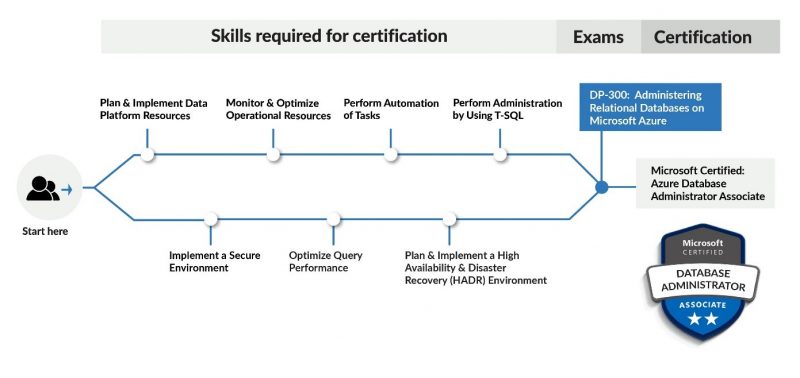Azure Database Administration?
An Azure Database Administrator is responsible for implementing, managing, troubleshooting and operating the data related solution using the cloud-native and hybrid data platform solutions built on Microsoft Azure data services and Microsoft SQL Server. Working with technologies such as Azure SQL Databases, Azure Managed Instance, SQL Server on Azure Virtual Machines and Azure Databases for MySQL, PostgreSQL and MariaDB.
The Azure Database Administrator ensures that the data stored in these relational database engines is always available for the users and the applications that the data is secured while being held in the database files.
Th e DP-300 exam is aimed at candidates that are database administrators and data management specialists that manage on-premises and cloud relational databases build with Microsoft SQL Server and Microsoft Azure Data Services.
Who is it for and are there any prerequisites?
While there are no official prerequisites, it would be best to have some general knowledge and understanding of:
- Key relational database concepts.
- Virtualisation concepts including virtual machines and virtual networking.
- On-premises SQL Server basic configurations.
- T-SQL for querying SQL Server databases and data administration.
If you are new to Azure, make sure you first pass the DP-900 (Azure Data Fundamentals) to obtain some general knowledge and familiarity with the Azure platform.
Exam overview
DP-300 measures your intermediate-level knowledge on the following main areas:
- Plan and implement data platform resources (15-20%)
- Implement a secure environment (15-20%)
- Monitor and optimize operational resources (15-20%)
- Optimize query performance (5-10%)
- Perform automation of tasks (10-15%)
- Plan and implement a High Availability and Disaster Recovery (HADR) environment (15-20%)
- Perform administration by using T-SQL (10-15%)
Since this is one of the more recent Microsoft exams, the measured skills are often updated, so make sure you download the latest exam skills outline.
Exam structure
If you have attended any Microsoft exam then you must know that there is a standard passing score across all exams, which is seventy percent. This is also true for DP-300. However, the number of questions may differ. On its official page, Microsoft says that there can be anywhere between forty to sixty questions. However, I got sixty-two on my exam. You need to answer all of them within 120 minutes, which could be a challenge, especially when you come across a study case.
The study case is a group of related questions, based on a case that you need to carefully read. Reading the case twice may well take you over five minutes as it could be explained in detail. Most likely you won’t need all details to answer the questions. Be aware that you might get more than one case study. I had two on my exam, which took me over 10 minutes of reading and left me with less than two minutes per question in total. In general, you need to be prepared to answer as many questions that are based on some scenario, which require a solid understanding of the exam topics. Also take into consideration that the exam is measuring your intermediate-level knowledge, so don’t focus too much on a specific area, but instead try to cover large number of subjects, without going too deep in each of them.
In summary…
In summary, I would say that I dedicated two hours every day for over two months to be able to pass the exam, having in mind my background and knowledge.
If you have couple of years of experience, becoming a certified Azure database administrator will helps you draw your career path, showing that you are growing faster and opening better opportunities for you. On the other hand, as an expert in your field, becoming certified helps you verify your skills and be noticed and recognised globally.
If you enjoyed this blog, check out our full blog list here.



Introduction to Data Wrangler in Microsoft Fabric
What is Data Wrangler? A key selling point of Microsoft Fabric is the Data Science
Jul
Autogen Power BI Model in Tabular Editor
In the realm of business intelligence, Power BI has emerged as a powerful tool for
Jul
Microsoft Healthcare Accelerator for Fabric
Microsoft released the Healthcare Data Solutions in Microsoft Fabric in Q1 2024. It was introduced
Jul
Unlock the Power of Colour: Make Your Power BI Reports Pop
Colour is a powerful visual tool that can enhance the appeal and readability of your
Jul
Python vs. PySpark: Navigating Data Analytics in Databricks – Part 2
Part 2: Exploring Advanced Functionalities in Databricks Welcome back to our Databricks journey! In this
May
GPT-4 with Vision vs Custom Vision in Anomaly Detection
Businesses today are generating data at an unprecedented rate. Automated processing of data is essential
May
Exploring DALL·E Capabilities
What is DALL·E? DALL·E is text-to-image generation system developed by OpenAI using deep learning methodologies.
May
Using Copilot Studio to Develop a HR Policy Bot
The next addition to Microsoft’s generative AI and large language model tools is Microsoft Copilot
Apr